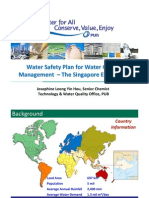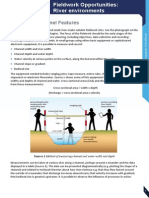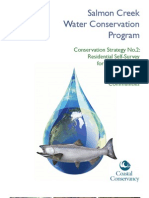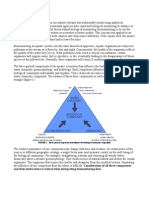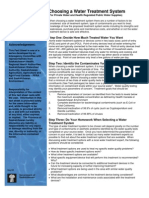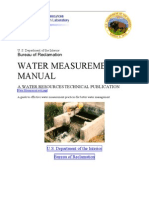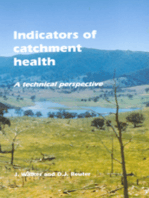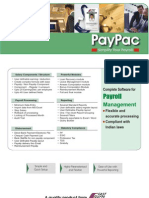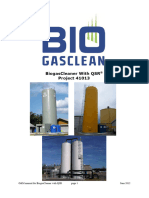Evaluating Water Quality: Self-Evaluation Techniques
Evaluating Water Quality: Self-Evaluation Techniques
Uploaded by
raymond909Copyright:
Available Formats
Evaluating Water Quality: Self-Evaluation Techniques
Evaluating Water Quality: Self-Evaluation Techniques
Uploaded by
raymond909Original Description:
Original Title
Copyright
Available Formats
Share this document
Did you find this document useful?
Is this content inappropriate?
Copyright:
Available Formats
Evaluating Water Quality: Self-Evaluation Techniques
Evaluating Water Quality: Self-Evaluation Techniques
Uploaded by
raymond909Copyright:
Available Formats
PUBLICATION 8118
FWQP FACT SHEET 5.2
Self-Evaluation Techniques:
Evaluating Water Quality
TERRY HALL is Water Quality Specialist, USDANRCS, San Benito County.
An essential tool in determining the effectiveness of land-use and management activ-
UNIVERSITY OF
CALIFORNIA
Division of Agriculture
and Natural Resources
http://anrcatalog.ucdavis.edu
In partnership with
http://www.nrcs.usda.gov
ities on your agricultural operation is the evaluation of water quality. Central Coast
growers want to know whether their efforts in installing expensive erosion controls
and adjusting their land use practices have improved water quality, or whether perhaps some other confounding influence such as regional geology or a point source
upstream of their operation is the source of the water quality problem they are trying
to address. The self-assessment data that you provide will be an important part of
your effort to document improvements in water quality that result from management
practices or to identify current or potential problems.
Scientists often undervalue simple field measurements and suspect that they
lack scientific validity, but properly designed and carefully executed self-assessment
techniques can provide sound data. Their strength lies in the potential for taking
large numbers of measurements inexpensively and with only semi-skilled assistance.
Keep in mind that water quality assessment is not a one-time event. You may need to
accumulate months or years worth of data before you can distinguish confounding
temporal and weather influences from the real impacts of land use or management
practices.
A Water Quality and
Technical Assistance
Program
for California Agriculture
Cover crop
Water
flow
Farm Water
Quality Planning
No cover crop
http://waterquality.ucanr.org
X
Ditch
Practice comparison
Figure 1. Assessment of a practices
effectiveness: comparing a treated
area to an untreated area. X indicates monitoring location.
Cover crop
Water
flow
This Fact Sheet is part of
the Farm Water Quality
Planning (FWQP) series,
developed for a short course
that provides training for
growers of irrigated crops
who are interested in implementing water quality protection practices. The short course
teaches the basic concepts of
watersheds, nonpoint source
pollution (NPS), self-assessment techniques, and evaluation techniques. Management
goals and practices are presented for a variety of cropping systems.
X
X
Filter strip
X
X
Sediment
basin
Ditch
Practice effectiveness
Figure 2. Above-and-below design
to assess the effectiveness of a practice.
X indicates monitoring location.
Where to Test
The key to effective water quality self-assessment is
the establishment of well-planned and concise objectives for your sampling effort. A good first step to
help you better understand your landscape would be
to review current and historical topographic maps
and aerial photos. It would also be helpful for you
to tour your property in order to try to get a sense
of where potential problems may lie and how you
should lay out your sampling sites (see Figures 1,
2, and 3). You will also want to take into account
the physical characteristics of the site such as
soil type, depth to ground water, slope, and distance
to the nearest surface water in
estimating vulnerNeighbor
ability. You can find
Your property
this information
X
in soil surveys (at
your local NRCS
office) or in drilling
X
records that you as
the landowner may
Neighbor
possess.
Upstream influence
Figure 3. Above-and-below design
to assess upstream offsite influences.
X indicates monitoring location.
ANR Publication 8118
2
You can begin your actual assessment by testing upstream (from the point where
the water body enters your property) and downstream (from the point where the water
body leaves your property). This will tell you how clean the water is when it flows
into your property and whether or not conditions on your property are contributing
to downstream water quality problems. If a given measured parameter is higher at the
downstream end of your property than at the upstream end, test the water at locations
likely to be contributing to the water body. Areas to sample might include
upstream and downstream from an established erosion control practice
irrigation runoff areas
seasonal and perennial streams
animal confinement areas
any low spot where water is leaving your property
If you are sampling irrigation water before it reaches the field, make sure to collect your sample as close to the wellhead as possible. Also, make sure that the well
is purged sufficiently (3 to 10 well-bore volumes) before sampling to ensure that the
sample is representative of the ground water.
When to Test
The concentration of most nutrients, chemicals, and pathogens during a storm event
tends to rise and fall in a pattern correlated to rainfall intensity, and for this reason you
should consider sampling before, during, and after the storm event. Storm event sampling is extremely important because the majority of the annual water flow and nonpoint source constituent loading occurs during major storm events, which are few in
the Central Coast region. You might also think about scheduling your sampling around
planting periods (preplant vs. postplant vs. harvest) or at collection points (field runoff, ditch, or tile drains) during an irrigation event.
To begin, set up a sampling schedule. Consider how many sites you plan to
sample and whether or not sampling is feasible year-round (e.g., periodic drought or
flooding may make sampling impractical). Think about the types of test you will perform, how much time they will require, and what goals you have set (e.g., to learn to
recognize water quality problems and their sources, and to know what can be done to
alleviate the specific problems).
Testing should be done once a month throughout the year, and more often
during the winter rainy season, especially after any significant storm event.
Runoff from early rains can have high concentrations of nutrients or animal
wastes that have accumulated during the dry summer months. Water testing
should be conducted during the first storm that causes runoff.
Testing should be done immediately after each significant storm event. Rainfall
of 1 inch (2.5 cm) or more within 24 hours poses the greatest risk.
Reliability of Collected Information
To obtain high-quality data, you must follow appropriate protocols. Growers who
choose to evaluate water quality for themselves strive to obtain the best data possible.
This is important, since you, the grower, are the primary user of this information.
Following are suggestions for ways to improve the quality of your water sampling data.
A well-thought-out plan can help ensure that your test results are both accurate
and precise. Accuracy refers to how close a measurement is to the true value. Precision
refers to the ability to obtain consistent results. To achieve reliability in both accuracy
and precision,
select the proper sampling sites
ANR Publication 8118
keep consistent with protocols, site location, and time of day sample is collected
triple-rinse bottles with sample water before you collect the sample and with
distilled water after you complete the test
perform the test immediately after you collect the water sample
carefully use and maintain your testing equipment
follow the specific directions of each testing protocol exactly as described
repeat measurements to check for accuracy and to understand any sources
of error
store test kits away from heat and light (refrigerate them if possible)
minimize contamination of your test equipment and check the expiration dates
on any chemicals
Standards, Blanks, and Splits
A standard is a sample of known concentration. You can buy standards from a nearby
lab. A blank is a sample run using distilled water. By testing standards and blanks, you
can check for bad reagents and equipment contamination. A split is one sample tested
twice (for example, two nitrate tests performed out of the same bottle of water taken
from a stream or irrigation ditch). Splits test for operator error, as both tests should
yield the same results. You should consider using standards, blanks, or splits whenever
you doubt the accuracy of your results or when any chemical reagent is approaching its
expiration date.
Repeated Measurements
There are two good reasons for you to repeat measurements, and both have to do with
improving the quality of your data. First, streams are variable. The water that flows past
a point in the stream is constantly changing. By taking two or three measurements and
averaging the values, you take into account some of the natural variations within the
stream and obtain a better, more representative overall value. Second, when you take
more than one measurement you reduce the chance that you will record incorrect data.
Lets Not Forget Safety!
Always let someone know where you are, especially if you are monitoring a stream.
Have a first-aid kit handy.
Consider wearing surgical gloves.
Be mindful of slippery rocks and unseen objects when you walk in moving water.
Know chemical clean-up, disposal, and first-aid procedures.
Do not eat food after handling chemicals.
CONSTITUENTS OF WATER AND THEIR IMPORTANCE
What Is Ammonia?
Ammonia (NH3), a form of nitrogen, is commonly found in terrestrial and aquatic ecosystems. Other forms of nitrogen include ammonium (NH4+), nitrates
(NO3-), and nitrites (NO2-). Ammonia is a colorless gas at standard temperature and
pressure and is very soluble in low-pH (acidic) water.
Ammonia levels in zero-salinity surface water increase with increasing pH and
temperature. Under low pH and temperature conditions, ammonia combines with
water (H2O) to produce an ammonium ion (NH4+) and a hydroxide ion (OH-). The
ammonium ion is nontoxic and not of concern to organisms. Above a pH of 9, however,
ammonia is of major concern. Excess ammonia (NH3) may accumulate in an organism
and cause changes in its metabolism or increases in its body pH. Fish may be subject to
ANR Publication 8118
poorer hatching success, reductions in growth rate and morphological development,
and injuries to gill, liver, and kidney tissues.
What Is Dissolved Oxygen?
Oxygen in its dissolved form in water is measured as dissolved oxygen (DO). A stream
system both produces and consumes oxygen. It gains oxygen from the atmosphere and
from plants as a result of photosynthesis. Because running water churns, it dissolves
more oxygen than still water. Respiration by aquatic animals, decomposition, and various chemical reactions consume oxygen in the water. DO levels fluctuate both seasonally and over a 24-hour period. Levels also vary with changes in water temperature
and altitude.
Oxygen is as important to life in water as it is to life on land. Most aquatic plants
and animals require oxygen for survival and the availability of oxygen affects their
growth and development. When excessive organic materials such as animal waste enter
a stream, microorganisms in the water feed on this organic material and consume DO
in the process. With warm temperatures, these microorganisms can proliferate to such a
degree that their consumption of DO will suffocate fish and other aquatic life.
What Are Nitrates?
Nitrates (NO3-) are another form of nitrogen. Nitrates from land sources end up in
water bodies more quickly than other nutrients such as phosphorus. This is because
they dissolve in water more readily than phosphates, which have a stronger affinity for
soil particles. Together with phosphorus, nitrates in excessive amounts can cause dramatic increases in aquatic plant growth, which in turn reduces dissolved oxygen (DO)
concentrations. Elevated levels of nitrates can be toxic to humans, especially children,
because the nitrates prevent hemoglobin from binding oxygen and transporting it to
vital tissues.
What Is pH?
The alkalinity or acidity of a solution is described in terms of the solutions pH level.
Water (H2O) contains both hydrogen ions (H+) and hydroxide ions (OH-). The relative
concentrations of these ions determine whether a solution is acidic or basic (alkaline).
The pH scale ranges from 1 (most acidic) to 14 (most basic), with 7 (pure water)
being neutral. It is important to remember that pH is measured on a logarithmic scale:
A change of 1 pH means a ten-fold change in the ion concentrations.
The pH value affects many chemical and biological processes in the water. For
example, different organisms flourish within different ranges of pH. The largest variety
of aquatic animals prefers a pH range of 6.5 to 8.5. When the pH value falls outside of
this range, the streams biological diversity suffers because of stresses to the physiological systems of most organisms that can, among other things, reduce reproduction. Low
pH conditions can also allow toxic elements and compounds to become available for
uptake by plants and animals.
What Is Phosphorus?
Phosphorus is the eleventh-most abundant mineral in the earths crust and commonly
occurs in water in the form of phosphate ions (HPO42- and H2PO4-). Phosphorus is
in short supply in most water bodies, but even a modest increase in phosphorus can,
under the right conditions, set off a chain of undesirable events in a stream including
accelerated plant growth, algae blooms, decreased dissolved oxygen, and the death of
certain fish and invertebrates. Unlike nitrogen and other nutrients, phosphorus does
not have a gaseous phase; it adsorbs to soil particles or is incorporated into organic
matter. Once phosphorus enters an aquatic system, it tends to remain there unless
physically removed.
ANR Publication 8118
5
What Are Salinity and Conductivity?
Conductivity is a measure of the ability of water to pass an electric current. It is used
to determine the salinity of water. The natural concentration of salts in a waterway is
largely influenced by the geology of the area through which the water flows. Streams
that run through areas with clay soils (e.g., ancient marine sediments) tend to have
higher conductivity because of the presence of materials that ionize when washed into
water.
High salinity may interfere with the growth of aquatic vegetation. Salt may
decrease the osmotic pressure, causing water to flow out of the plant in order to achieve
equilibrium, and this in turn causes stunted growth, leaf tip burn and marginal leaf
burn, bleaching, or defoliation. Some freshwater organisms are salt tolerant and may
invade or replace native species.
Inadequate drainage or excessive evaporation from agricultural fields may lead to
an accumulation of salts in the soil. High salt concentrations in the soil around plant
roots may cause plant dehydration by reversing osmotic conditions. In some cases, rather than destroying a crop, elevated salt levels may simply reduce crop yields and leave
the plants prone to disease.
Why Is Temperature Important?
The rates of biological and chemical processes depend on temperature. Temperature
affects
1. dissolved oxygen levels Colder water can hold more dissolved oxygen than
warmer water, so colder water generally has a higher diversity of macroinvertebrates. Warmer water has less dissolved oxygen. Lower oxygen levels weaken
fish and aquatic insects, making them more susceptible to illness and disease.
2. rate of photosynthesis Photosynthesis by algae and aquatic plants increases
with increasing temperature. Increased plant/algae growth leads to increased
death and decomposition, resulting in increased oxygen consumption by
bacteria.
3. metabolic rates of aquatic organisms Many animals require specific temperatures for survival. Water temperature controls their metabolic rates, and
most organisms operate efficiently within a limited temperature range. Aquatic
organisms die when temperatures become too high or too low. Fish species are
particularly sensitive to temperature changes, which can affect reproduction and
the growth of juveniles.
What Is Turbidity?
Turbidity is the measure of water clarity, the degree to which suspended material in the
water decreases the passage of light through the water. Higher turbidity increases water
temperatures because the suspended particles in water absorb heat. This reduces the
waters concentration of dissolved oxygen (DO), since warm water holds less DO than
cold water. Higher turbidity also reduces the amount of light that can penetrate the
water, which reduces photosynthesis and the production of DO. Suspended particles
can clog the gills of fish. If the particles settle out of the water, they can smother spawning beds (gravel), fish eggs, and benthic organisms. Sediment can also carry pathogens,
nutrients, and pesticides downstream.
Note that turbidity is not a measurement of the amount of suspended solids present or the rate of sedimentation in a stream; it measures only the scattering of light by
suspended particles. Measurement of total solids is a more direct means for measuring
the amount of material suspended and dissolved in the water.
ANR Publication 8118
Table 1. Water quality tests and what they measure
Test for
Why measure it?
Measuring tools
Ammonia
Toxic levels of ammonia can kill sh and other aquatic organisms.
Water temperatures strongly inuence the toxicity of ammonia.
Ammonia test kit or ammonia
meter
Dissolved O2 (DO)
Low levels of dissolved oxygen affect the growth and development of plants and animals.
Dissolved oxygen test kit or meter
Nitrate
If enough phosphorus is available, a high concentration of nitrates Nitrate test kit, meter, or test
will result in an increase in algae growth.
strips
pH
pH affects many chemical and biological processes in the water.
Meter or litmus test strips
Phosphorus
If too much phosphate is present, algae blooms may develop that
could later lead to the depletion of dissolved oxygen.
Phosphate test kit, meter, or test
strips
Salinity/ conductivity
The level of salinity in water is often critical to the survival of
many aquatic plants and animals.
Alkalinity (chloride) test kit or
TDS/conductivity meter
Temperature
Every aquatic organisms has upper and lower temperature limits;
temperatures outside these limits will affect the health of the
organism.
Alcohol-lled thermometer, if
available
Turbidity/sediment
Sediments can carry pollutants that bind to soil particles. They can
also have a negative affect on sh health and spawning habitat.
Imhoff cone or turbidity meter
NOTE: There are many different constituents you can test for and many different methods for measuring them. Several commercial
sources for tests are listed at the end of this publication.
WATER QUALITY SELF-EVALUATION
Ammonia
How do I measure ammonia? Ammonia test kits determine ammonia (nitrogen)
levels by comparing water samples mixed with pre-measured reagents against
color standards. The ranges of detection are 0 to 1 and 1 to 10 mg/L. Ammonia
test kits cost $45 and up (sufficient for 30 tests). Tests take approximately 10
minutes to complete.
Ammonia-specific meters determine ammonia levels by reading a change
in color using a silicon photocell on an LCD. Simply add reagents to a water
sample and place the vial into the meter. The range of detection is 0 to 1 mg/L
with a resolution of 0.01 mg/L. Meters cost $200 and up. Tests take 10 to 15
minutes to complete.
Laboratory testing requires that you collect a water sample according to
lab specifications. Mail your sample to the lab or drop it off. Costs range from
$25 to $35. Processing can take 1 to 7 days. Accuracy is assumed to be absolute.
Where do I test for ammonia? Conduct your test anywhere water leaves
your farm, especially after you apply ammonia-rich fertilizer or if livestock are
present. If applicable, take tests where water enters and leaves your property.
When do I test for ammonia? Test for ammonia during your scheduled
irrigation activities and during the first rain event following the application of
ammonia-rich fertilizer. Always measure pH and temperature when you measure ammonia. Without these other measurements it will be difficult to evaluate the true value of your ammonia sample.
Water quality objectives for the Central Coast
Beneficial use of concern: General objective = The discharge of wastes
should not cause concentrations of un-ionized ammonia (NH3) to
exceed 0.025 mg/L as nitrogen in receiving waters.
ANR Publication 8118
7
Dissolved Oxygen
How do I measure dissolved oxygen (DO)? Dissolved oxygen test kits determine DO levels by comparing water samples mixed with pre-measured
reagents against color standards. The range of detection is 1 to 12 mg/L. DO
test kits cost $40 and up (sufficient for 30 tests). Tests take approximately 10
minutes to complete.
Dissolved oxygen-specific meters determine DO levels by reading a change
in color using a silicon photocell on an LCD. Simply add reagents to a water
sample and place the vial into the meter. The range of detection is 0 to 14
mg/L with a resolution of 0.1 mg/L. Meters cost $180 and up. Tests take 10
minutes to complete.
Hand-held DO meters give fast and accurate readings. Place the attached
probe into your water sample. The range of detection is 0 to 50 mg/L. Meters
cost $250 and up. The digital readout is ready in 20 seconds.
Laboratory testing requires that you collect a water sample according to lab
specifications. Mail your sample to the lab or drop it off. Costs range from $20
to $30. Processing can take 1 to 7 days. Accuracy is assumed to be absolute.
Where do I test for DO? Rapid decomposition of organic matter, high
ammonia concentrations, high air temperatures, and lack of turbulence all
contribute to lowered DO levels. Conduct your test at midstream, making sure
to sample from the middle of the water column, if possible.
When do I test for DO? Measure for DO once a month if you have a
stream running through your property. Remember to be consistent in the time
of day you take your sample. Depending on your site, you should be able to
document a change in values between the summer (low-flow) and winter
(high-flow) months.
Regional Water Quality Control Board water quality objectives for the
Central Coast
Beneficial use of concern: Cold/warm freshwater habitat and fish spawning = DO concentration should not fall below 7.0 mg/L for waters that
support cold-water fishes or 5.0 mg/L for waters that support warmwater fishes. For fish spawning, DO should not fall below 7.0 mg/L.
Nitrate
How do I measure nitrate? Nitrate test kits determine nitrate levels by comparing water samples mixed with pre-measured reagents against color standards.
The ranges of detection are 0 to 25 and 25 to 125 mg/L. Nitrate test kits cost
$50 and up (sufficient for 30 tests). Tests take 10 minutes to complete.
Nitrate-specific meters determine nitrate levels by reading a change in
color using a silicon photocell on an LCD. Simply add reagents to a water
sample and place the vial into the meter. The range of detection is 0 to 30
mg/L with a resolution of 0.1 mg/L. Meters cost $150 and up. Tests take 10
minutes to complete.
RQflex meters can be programmed to provide accurate results in seconds
for a wide variety of tests. Simply dip the test strip in the sample, insert the
strip into the meter, and read the results on the digital display. The range of
detection is 3 to 90 mg/L. Meters cost approximately $575. Tests take 10
minutes to complete.
Laboratory testing requires that you collect a water sample according to lab
specifications. Mail the sample to the lab or drop it off. Costs range from $25 to
$35. Processing can take 1 to 7 days. Accuracy is assumed to be absolute.
ANR Publication 8118
8
Where do I test for nitrates? Collect your sample above and below any
potential nitrate source. For example, take your samples from a stream above
an area where water enters the stream from your farm, and again below the
runoff area. If a stream does not flow through your property, you can sample
anywhere water leaves your farm.
When do I test for nitrates? Test for nitrates during your scheduled irrigation activities and during the first rain event after fertilizer application.
Regional Water Quality Control Board water quality objectives for the
Central Coast
Beneficial use of concern: General objective = All waters shall be maintained free of toxic substances in concentrations that are toxic to or
that produce detrimental physiological responses in human, plant, animal, or aquatic life. Compliance with this objective will be determined
by use of indicator organisms, analysis of species diversity, or other
appropriate methods specified by the Regional Board.
pH (Power of Hydrogen)
How do I measure pH? Pocket pH meters display immediate results with a high
degree of accuracy (0.2 pH). Meters should be calibrated frequently to maintain accuracy (recommend calibration solutions of 7 and 10 pH). Pocket pH
meters cost $40 and up. Calibration solutions cost $8 each. Testing takes 10
minutes to complete.
pH test strips measure pH from 0.0 to 13.0 with a simple, single-color
match for each pH value. Simply dip the strip into the water sample and compare it to the color chart. pH strips are not as accurate (0.5 pH) as meters,
but they are easier to use because they do not require calibration. Use strips
only to get a general idea of the pH. Cost is $8 and up (100 strips per package). Testing takes 2 minutes to complete.
Laboratory testing requires that you collect your water sample according to
lab specifications. Mail the sample to the lab or drop it off. Costs range from $10
to $25. Processing can take 1 to 7 days. Accuracy is assumed to be absolute.
Where do I test for pH? Conduct your test above and below any area
where livestock are confined. You should also test above and below any point
where water leaves your property and enters a water body.
When do I test for pH? Measure pH once a month if livestock are present.
Since aquatic organisms are sensitive to pH, especially during reproduction, you
may wish to measure pH once a week during spring and summer months. Note
that higher-temperature water bodies have slightly lower pH values.
Regional Water Quality Control Board water quality objectives for the
Central Coast
Beneficial use of concern: Municipal/domestic supply, agriculture supply,
contact and non-contact water recreation = pH should fall between 6.5
and 8.5;
Cold/warm freshwater or marine habitat = pH should range between
7.0 and 8.5. Changes in normal pH should not exceed 0.5 for cold- or
warm-water fisheries or 0.2 for marine habitats.
Phosphate
How do I measure phosphate? Phosphate test kits determine phosphate levels
by comparing water samples mixed with pre-measured reagents against color
standards. The ranges of detection are 0 to 1 and 1 to 10 mg/L. Phosphate test
kits cost $45 and up (30 tests). Tests take 10 minutes to complete.
ANR Publication 8118
9
Phosphate-specific meters determine phosphate levels by reading a change
in color using a silicon photocell on an LCD. Simply add reagents to a water
sample and place the vial into the meter. The range of detection is 0 to 2.5
mg/L with a resolution of 0.1 mg/L. Meters cost $170. Tests take 10 minutes to
complete.
Laboratory testing requires that you collect a water sample according to lab
specifications. Mail the sample to the lab or drop it off. Costs range from $25
to $35 for orthophosphate and $40 to $75 for total phosphate. Processing can
take 1 to 7 days. Accuracy is assumed to be absolute.
Where do I test for phosphate? Since phosphate enters surface water
in organic matter (dead plants, animals, and animal waste), attached to soil
particles, or through detergents and fertilizers, you will want to test above and
below any water body where there is a livestock confinement area or above
and below a management practice if you want to measure its effectiveness. If
this is not applicable, conduct your test anywhere water leaves your property.
When do I test for phosphate? Test for phosphate during your scheduled
irrigation activities and during the first rain event after you apply fertilizers.
Regional Water Quality Control Board water quality objectives for the
Central Coast
Beneficial use of concern: General objective = All waters shall be maintained free of toxic substances in concentrations that are toxic to or
produce detrimental physiological responses in human, plant, animal,
or aquatic life. Compliance with this objective will be determined by
use of indicator organisms, analysis of species diversity, or other appropriate methods specified by the Regional Board.
Salinity and Conductivity
How do I measure salinity or conductivity? A TDS or conductivity tester measures salt content. To use the instrument, place it into your water sample. This
equipment features automatic temperature compensation with a 2% degree of
accuracy, but testers do require calibration. A typical unit costs $60. Test takes
10 minutes to complete.
Refractometers measure the concentration of dissolved substances in liquid based on the principle of light refraction. Only 1 to 2 drops of solution are
required for measurement. A refractometer reads in parts per thousand (0 to
100 ppt) or specific gravity (1.000 to 1.070 sp. gr.). Units cost $150. Test takes
10 minutes.
A combination tester is a floating, waterproof instrument that allows you
to accurately measure the pH, conductivity, TDS, or temperature of a solution
without switching meters. The tester features automatic temperature compensation and auto-calibration. It comes with pH buffer solutions (4.0 and 7.0),
a pH electrode, four 1.5 volt batteries, and an electrode replacement tool, and
costs $145. Test takes 10 minutes to complete.
Laboratory testing requires that you collect a water sample according to lab
specifications. Mail the sample to the lab or drop it off. Costs range from $20 to
$30. Processing can take 1 to 7 days. Accuracy is assumed to be absolute.
Where do I test for salinity? Test for salinity at the wellhead or in any
area where water collects (e.g., a tailwater ditch) or leaves your property. You
may also want to test your runoff or a stream section above and below a management practice.
ANR Publication 8118
10
When do I test for salinity? Test your water at least twice per year (6-month
intervals). If you are testing runoff from a field, wait until the field becomes saturated
before you take a runoff sample.
Regional Water Quality Control Board water quality objectives for the
Central Coast
Beneficial use of concern: General objectives = There are no objectives for conductivity, but there are objectives for total dissolved solids (TDS). The TDS
objectives range from 150 to 1400 mg/L depending on the water body.
Temperature
How do I measure temperature? An armored thermometer that does not use mercury
costs approximately $20. For best results, immerse the thermometer in the middle of
the water column and allow sufficient time for the thermometer to achieve equilibrium. Try to take your reading while the thermometer is still under water.
A digital thermometer displays the time and temperature. Place the thermometers
probe into the middle of the water column. Even though you will get an immediate
reading, allow sufficient time for the thermometer to adjust. The range of detection is
0 to 160F (18 to 71C). This type of thermometer costs approximately $40.
Where do I test for temperature? You should test for changes in stream temperature above and below an area where runoff occurs. If you have a stream running
through your property you may want to take a temperature reading one-half mile
above and below your property line and compare those readings with readings taken
on your property. Remember that warmer water holds less oxygen, so if you also test
for dissolved oxygen you should see a correlation. Also, keep in mind that ammonia
levels increase with increasing temperature.
When do I test for temperature? Measure water temperature at the same location
once a month. You may wish to test more frequently (once a week) during prolonged
periods of hot or cold climatic conditions. This will provide you with a general indication of the rate at which the water temperature is changing.
Regional Water Quality Control Board water quality objectives for the
Central Coast
Beneficial use of concern: Cold/warm freshwater habitat = Temperature should
not increase more than 5F (2.8C) above natural receiving waters.
Turbidity
How do I measure turbidity? Turbidity can be measured in Jackson Turbidity Units
(JTU) or Nephelometric Turbidity Units (NTU). Their values are not interchangeable.
Turbidity test kits determine turbidity levels by comparing water samples mixed with
pre-measured reagents against color standards. The range of detection is 5 to 100 JTU.
Turbidity kits cost $45 (50 tests). Tests take approximately 10 minutes to complete.
Turbidity meters are also available and are simple to use. Just place the vial of sampled water into the meter. The range of detection is 0 to 1100 NTU. Meters cost $650
and up. Test takes 10 minute to complete.
Laboratory testing requires that you collect a water sample according to lab
specifications. Mail the sample to the lab or drop it off. Costs range from $15 to $25.
Processing can take 1 to 7 days. Accuracy is assumed to be absolute.
Where do I test for turbidity? Collect your sample above and below a potential
source of erosion. For example, take your sample from a stream above the area where
water enters the stream from your farm and again below the same area where runoff
enters the stream. If a stream does not flow through your property, you can sample
anywhere that water leaves your farm.
11
ANR Publication 8118
When do I test for turbidity? Test for turbidity during your scheduled irrigation
activities and during any significant rain event throughout the winter season.
Regional Water Quality Control Board water quality objectives for the
Central Coast
Beneficial use of concern: General objective = Water quality objectives for turbidity require that surface waters be free of changes that cause nuisance or adversely
affect the beneficial uses of water. If natural turbidity is 0 to 50 JTU, the maximum increase in inputs is 20%. If 50 to 100 JTU, the maximum increase in
inputs is 10 JTU. If >100 JTU, the maximum increase in inputs is 10%.
Where to Purchase Test Kits and Other Equipment
Before you purchase any water quality test kits or other sampling equipment, contact your local Water District, UC Cooperative Extension, or Natural Resources
Conservation Service/Resource Conservation District office. They can help you make
sure that you get the proper test or equipment for your particular needs.
Estimated Pricing for Water Quality Tests (as of 8/1/04)
(Shelf life of 6 months at room temperature, 1 year if refrigerated)
Ammonia test kit, 30 tests
$45
Dissolved oxygen (DO) test kit, 30 tests
$40
Imhoff cone (1000 ml) for turbidity
$25
Imhoff cone stand (holds 3 cones)
$25
Nitrate test kit, 30 tests
$50
pH test strip, 100/package
$8
Phosphate test kit, 30 tests
$45
Salinity test kit (chloride), 50 tests
$60
Thermometer
$20
Approximate Lab Cost for Individual Tests (as of 8/1/04)
Ammonia
$25
Dissolved oxygen (DO)
$20
Nitrate
$25
Orthophosphate
$25
pH
$10
Salinity (chloride)
$20
Total dissolved solids (TDS)
$20
Total phosphate
$40
Turbidity
$15
Suppliers of Water Test Kits and Equipment
Ben Meadows. 1-800-241-6401, http://www.benmeadows.com
Chemetrics, Inc. 1-800-356-3072, http://www.chemetrics.com
Cole Parmer Instrument Company. 1-800-323-4340, http://www.coleparmer.com
Forestry Suppliers, Inc. 1-800-647-5368, http://www.forestry-suppliers.com
Hach Company. 1-800-227-4224, http://www.hach.com
LaMotte. 1-800-344-3100, http://www.lamotte.com
NOTE: Test kits and electronic meters used to measure different concentrations
among selective ions are highly variable, so it is important that you know what degree
of accuracy you are striving to achieve before you select a product.
12
ANR Publication 8118
DISPOSAL OF CHEMICAL WASTES
In any self-assessment program that performs chemical testing, you face the problem
of how to dispose of chemical wastes. These include individual unused reagents and
reacted sample waste (the waste generated during performance of tests).
Unused Reagents
You can reduce or eliminate the problem of leftover reagents by ordering quantities
that take into account the reagents shelf life and your rate of usage. Instructions for
disposal of each reagent are included on the Material Safety Data Sheet (MSDS) provided by the manufacturer. Modest quantities of many common test kit reagents can
safely be diluted and disposed of down the drain if you take necessary precautions
regarding incompatibility. For example, you should neutralize acids and bases before
disposal (see instructions on the MSDS). Note that neutralization often occurs as part
of the test procedure, making the disposal of reacted sample waste simpler than disposal of unused reagents. For example, the reagents used in the dissolved oxygen test
include both an acid (sulfuric acid) and a base (alkaline potassium iodide azide), but
these neutralize each other when you perform the test.
Often the final instruction on an MSDS is dispose of in accordance with applicable federal, state, and local regulations. People who use chemicals need to educate
themselves on the regulations for their area and make a plan that follows those regulations and emphasizes prudent and responsible practices.
Tip: Form an alliance with the laboratory personnel at the agencies that deal
with waste disposal regulations for your area. They should be familiar with the tests
you are performing and may be able to provide advice and support. It is also very
helpful to contact local government recycling coordinators and find out about household hazardous waste programs.
Reacted Sample Waste
Bring a designated waste receptacle to your sampling site whenever you perform chemical testing. Most chemical tests that are commonly used in volunteer programs produce
wastes that can safely be disposed of by pouring them down the drain if it is flushed
with plenty of water. These include field kits for testing dissolved oxygen, pH, phosphorus, turbidity, and alkalinity. A few test procedures include heavy metals that are not
neutralized in the test procedure. These might include nitrate or ammonia tests. As a
precaution, if you are using a reagent that comes in a packet, be sure to hold the packet
away from your face and stand upwind of the packet when opening it.
Tip: To discard chemical waste, take two separate containers with secure lids
(such as recycled margarine containers). Label one container Hazardous Waste and
the other Non-Hazardous Waste. Place all liquids and solids in the plastic containers along with several cups of clean clay cat litter. Leave the lids off so the liquid can
evaporate. The hazardous and non-hazardous chemical wastes are now in solid form.
For information on how to dispose of the hazardous waste, contact a lab or the
Solid Waste Management District in your area. The non-hazardous wastes, once in
solid form, can be thrown away with your regular trash.
13
ANR Publication 8118
Worksheet for Evaluating Water Quality
Your name:
Date:
Time:
Air temperature:
Site name:
Site description (describe location and current condition of water, vegetation, and land uses on and
above your property):
Measurement taken from: Irrigation water (wellhead/eld runoff)
Weather in past 48 hours: Clear
Flow conditions:
Dry
Overcast
Stagnant
Showers
Slow
Surface water (stream/creek)
Steady rain
Moderate
Storm (heavy)
High
Flood
Method/equipment used to measure:
Ammonia _________________________________ Phosphorus ____________________________________
Dissolved oxygen ___________________________ Salinity/conductivity _____________________________
Nitrate ___________________________________ Turbidity ______________________________________
pH ______________________________________
Units*
Ammonia
mg/L
Dissolved oxygen
mg/L
Nitrate
mg/L
Sample 1
Sample 2
Average
Upstream Temp.:
Downstream Temp.:
Difference:
pH
Phosphorus
mg/L
Salinity/conductivity
mg/L or S/cm
Turbidity
NTU or JTU
Temperature
C or F
Comments:
* Milligrams per liter (mg/L) is the equivalent to parts per million (ppm).
Indicate which type of test is conducted (e.g., nitrate or nitrate-nitrogen, phosphate or orthophosphate, etc.).
14
ANR Publication 8118
FOR MORE INFORMATION
Youll find detailed information on many aspects of water quality and resource conservation in these titles and in other publications, slide sets, CD-ROMs, and videos from
UC ANR:
Developing a Farm Map, Publication 8062
Developing a Nonpoint Source Pollution Evaluation Program, Publication 8087
Fish Habitat in Freshwater Streams, Publication 8112
To download these products, visit our online catalog at http://anrcatalog.ucdavis.edu.
You can also place orders by mail, phone, or FAX, or request a printed catalog of publications, slide sets, CD-ROMs, and videos from
University of California
Agriculture and Natural Resources
Communication Services
6701 San Pablo Avenue, 2nd Floor
Oakland, California 94608-1239
Telephone: (800) 994-8849 or (510) 642-2431, FAX: (510) 643-5470
E-mail inquiries: danrcs@ucdavis.edu
An electronic version of this publication is available on the ANR Communication
Services Web site at http://anrcatalog.ucdavis.edu.
Publication 8118
2004 by the Regents of the University of California, Division of Agriculture and Natural Resources.
All rights reserved.
To simplify information, trade names of products have been used. No endorsement of named
products is intended, nor is criticism implied of simlar products that are not mentioned.
The University of California prohibits discrimination or harassment of any person on the basis
of race, color, national origin, religion, sex, gender identity, pregnancy (including childbirth, and
medical conditions related to pregnancy or childbirth), physical or mental disability, medical
condition (cancer-related or genetic characteristics), ancestry, marital status, age, sexual orientation, citizenship, or status as a covered veteran (covered veterans are special disabled veterans,
recently separated veterans, Vietnam era veterans, or any other veterans who served on active
duty during a war or in a campaign or expedition for which a campaign badge has been authorized) in any of its programs or activities.
University policy is intended to be consistent with the provisions of applicable State and Federal
laws.
Inquiries regarding the Universitys nondiscrimination policies may be directed to the Affirmative
Action/Staff Personnel Services Director, University of California, Agriculture and Natural
Resources, 300 Lakeside Drive, 6th Floor, Oakland, CA 94612-3550, (510) 987-0096. For information about obtaining this publication, call (800) 994-8849. For downloading information,
call (530) 754-5112.
pr-9/04-WJC/CR
ISBN 978-1-60107-297-9
This publication has been anonymously peer reviewed for technical accuracy by University of
California scientists and other qualified professionals. The review process was managed by the
ANR Associate Editor for Natural Resources.
You might also like
- 1-Water Safety Plan For Water Quality Management - PUB SingaporeDocument33 pages1-Water Safety Plan For Water Quality Management - PUB SingaporeJason LimNo ratings yet
- Dark Elf Playbook For Blood BowlDocument6 pagesDark Elf Playbook For Blood Bowlairfix1999No ratings yet
- Friedman tHE RIGHT TO THE cITY PDFDocument17 pagesFriedman tHE RIGHT TO THE cITY PDFcybermonchingNo ratings yet
- Easy Lover BassTabDocument2 pagesEasy Lover BassTabRoger0% (1)
- 1440479406-Topic 19 Sampling&PreparationDocument32 pages1440479406-Topic 19 Sampling&PreparationSunil Babu KhatryNo ratings yet
- Reportsedit 291021163550754082Document22 pagesReportsedit 291021163550754082AlameldeenAlameldeenkhareefNo ratings yet
- CWAM - II - 2 - Water Quality Disco de SecchiDocument41 pagesCWAM - II - 2 - Water Quality Disco de SecchiAline NeNo ratings yet
- Treatment Rivers Streams Galleries v1Document19 pagesTreatment Rivers Streams Galleries v1Furinaka NaretaNo ratings yet
- Water ConductivityDocument6 pagesWater ConductivitySandeep MishraNo ratings yet
- Crab As Shedding SystemDocument16 pagesCrab As Shedding Systemkiana Jessica MonroeNo ratings yet
- Reduce Leaks: Using Water Audits and Leak Detection SurveysDocument6 pagesReduce Leaks: Using Water Audits and Leak Detection SurveysBrandon AllenNo ratings yet
- Systematic Methods of Water Quality Parameters Analysis: Analytical MethodsFrom EverandSystematic Methods of Water Quality Parameters Analysis: Analytical MethodsRating: 1 out of 5 stars1/5 (1)
- IWT Sampling Bioassay Test Treatability StudyDocument44 pagesIWT Sampling Bioassay Test Treatability Studyharshu D100% (1)
- 2 U5 L Unit - 1Document7 pages2 U5 L Unit - 1Bharath SjNo ratings yet
- Water Sample TestingDocument68 pagesWater Sample TestingPrints BindingsNo ratings yet
- Geo IGCSEDocument3 pagesGeo IGCSEZeynep Akı100% (1)
- March - April 2008 Irrigation Newsletter, Kings River Conservation District NewsletterDocument1 pageMarch - April 2008 Irrigation Newsletter, Kings River Conservation District NewsletterKings River Conservation DistrictNo ratings yet
- Lecture Notes Course 3Document57 pagesLecture Notes Course 3RavitejaNo ratings yet
- Water QualityDocument41 pagesWater QualityPaschal MazikuNo ratings yet
- Chap 1 WogeeDocument28 pagesChap 1 WogeedreamteamNo ratings yet
- Environmental Monitoring by Fredrick MapongaDocument31 pagesEnvironmental Monitoring by Fredrick MapongaTinotenda KufaNo ratings yet
- Waste Water Sampling and Analysis: Submitted To Dr. Poonam Syal Associate Prof. Ee Dept. Nitttr CHDDocument23 pagesWaste Water Sampling and Analysis: Submitted To Dr. Poonam Syal Associate Prof. Ee Dept. Nitttr CHDnayankumargautam70No ratings yet
- QAQC - Data Quality VAMDocument38 pagesQAQC - Data Quality VAMQais Alsafasfeh100% (1)
- Chapter 3 Wastewater Management LatestDocument12 pagesChapter 3 Wastewater Management Latestriscelixegaming14No ratings yet
- Water Quality ManagementDocument39 pagesWater Quality ManagementEmman Cosme Gumanit Virtudazo100% (1)
- Salmon Creek Water Conservation: Residential Self-Survey For Efficient Water Use in Coastal California CommunitiesDocument15 pagesSalmon Creek Water Conservation: Residential Self-Survey For Efficient Water Use in Coastal California CommunitiesSalmon Creek Watershed CouncilNo ratings yet
- Practical Design NotesDocument51 pagesPractical Design Noteskarthikraja21No ratings yet
- Meaning of Biomontoring 97Document6 pagesMeaning of Biomontoring 97Kartik MulgundNo ratings yet
- Interactive Water FeaturesDocument5 pagesInteractive Water FeaturesAmeer AbbasNo ratings yet
- Choosing AWater Treatment SystemDocument4 pagesChoosing AWater Treatment SystemHue SamnhatNo ratings yet
- MWaterra Well Slug For Aquifer CharacterisationDocument6 pagesMWaterra Well Slug For Aquifer CharacterisationfredNo ratings yet
- UNIT3 (Mid 2)Document66 pagesUNIT3 (Mid 2)NIKHIL NEELINo ratings yet
- Reasech 111Document8 pagesReasech 111Joshua D.No ratings yet
- Water SamplingDocument128 pagesWater SamplingSia FiguronNo ratings yet
- Groundwater Sample Collection and Analysis Procedures: Petroleum Remediation ProgramDocument20 pagesGroundwater Sample Collection and Analysis Procedures: Petroleum Remediation ProgramDaniel JacksonNo ratings yet
- Course Expected Learning Outcomes: ES 356: Surface Water Quality Monitoring and Management (2 Units)Document56 pagesCourse Expected Learning Outcomes: ES 356: Surface Water Quality Monitoring and Management (2 Units)morisNo ratings yet
- Manual For Water Testing in Lab.Document36 pagesManual For Water Testing in Lab.pkgoyal1983No ratings yet
- Fire Hydrant FlushingDocument16 pagesFire Hydrant FlushingAhmed Omar0% (1)
- Copy-Ehs 503Document5 pagesCopy-Ehs 503jolenebakers0No ratings yet
- Neutron ProbeDocument2 pagesNeutron ProbeMuhammad ArifinNo ratings yet
- Groundwater Recharge Info Fact SheetDocument6 pagesGroundwater Recharge Info Fact SheetStukineNo ratings yet
- 6 - Indonesian - Drinking WaterDocument60 pages6 - Indonesian - Drinking WaterWahyu JuniantoNo ratings yet
- Chapter 5 DrainageDocument22 pagesChapter 5 DrainagenathanzdarikelozayiNo ratings yet
- Water Measurement ManualDocument317 pagesWater Measurement ManualJean BattellNo ratings yet
- Water Measurement ManualDocument317 pagesWater Measurement ManualefcarrionNo ratings yet
- PP 3Document22 pagesPP 3amanuel buzunaNo ratings yet
- Rain Water Harvesting DissertationDocument6 pagesRain Water Harvesting DissertationCheapestPaperWritingServiceUK100% (1)
- Finalsopls 1217Document17 pagesFinalsopls 1217Mariano RivaraNo ratings yet
- Drinking Water QualityDocument8 pagesDrinking Water Qualityeqbal.sayed@exensys.comNo ratings yet
- Irrigation Notes (Water Sources For Irrigation)Document2 pagesIrrigation Notes (Water Sources For Irrigation)Aziz Khan KakarNo ratings yet
- Why Population Forecasting Is Needed in Water Supply ProjectDocument13 pagesWhy Population Forecasting Is Needed in Water Supply ProjectKidane BeyeneNo ratings yet
- Data Collection and Sampling Techniques PreDocument27 pagesData Collection and Sampling Techniques PrePeter Jake PatriarcaNo ratings yet
- Proper SamplingDocument17 pagesProper SamplingPratik DiyoraNo ratings yet
- Standard methods for the examination of water and sewageFrom EverandStandard methods for the examination of water and sewageNo ratings yet
- Water Remote Sensing: Advancements in Computer Vision Techniques for Water Remote SensingFrom EverandWater Remote Sensing: Advancements in Computer Vision Techniques for Water Remote SensingNo ratings yet
- Beginner's Ultimate Guide to In-Ground Pool Maintenance: Tips to Keep Your Pool SparklingFrom EverandBeginner's Ultimate Guide to In-Ground Pool Maintenance: Tips to Keep Your Pool SparklingNo ratings yet
- Guide for Designing and Operating Seawater Systems in AquacultureFrom EverandGuide for Designing and Operating Seawater Systems in AquacultureNo ratings yet
- Outdoor Plumbing Projects: Installing and Maintaining Sprinklers, Pools, and Other Water Features: Homeowner Plumbing Help, #6From EverandOutdoor Plumbing Projects: Installing and Maintaining Sprinklers, Pools, and Other Water Features: Homeowner Plumbing Help, #6No ratings yet
- Clean Waters - A Comprehensive Guide to Water Purification in the United States and WorldwideFrom EverandClean Waters - A Comprehensive Guide to Water Purification in the United States and WorldwideNo ratings yet
- Rainwater Harvesting: Understanding the Basics of Rainwater Harvesting (Transform Your Home and Farm With Rainwater to Uncover Self-sufficiency Secrets)From EverandRainwater Harvesting: Understanding the Basics of Rainwater Harvesting (Transform Your Home and Farm With Rainwater to Uncover Self-sufficiency Secrets)No ratings yet
- ELECTRONIC COMPONENTS HandoutDocument22 pagesELECTRONIC COMPONENTS HandoutVineeth WilsonNo ratings yet
- Esci ResultsDocument23 pagesEsci Resultsapi-304738945No ratings yet
- Syllbus 4 Marketing 4th SEMDocument5 pagesSyllbus 4 Marketing 4th SEMAmit VermaNo ratings yet
- 7609WU ArDocument62 pages7609WU ArNizar ManaiNo ratings yet
- Difference Betwn Gross Salary, CTCDocument8 pagesDifference Betwn Gross Salary, CTCabdulyunus_amir100% (1)
- Image Processing With Opencv Python: Kripasindhu SarkarDocument67 pagesImage Processing With Opencv Python: Kripasindhu SarkarDevenNo ratings yet
- Progress Review - 1 PDFDocument2 pagesProgress Review - 1 PDFStela PishtyalovaNo ratings yet
- Tutorial CSI Bridge Video 1 & 2Document38 pagesTutorial CSI Bridge Video 1 & 2Andreas ChrisNo ratings yet
- محاضرات أمنية تصميم البرمجياتDocument74 pagesمحاضرات أمنية تصميم البرمجياتWalid AlsharafiNo ratings yet
- MORPHOLOGYDocument11 pagesMORPHOLOGYputri novaNo ratings yet
- BookSlides 5B Similarity-based-LearningDocument69 pagesBookSlides 5B Similarity-based-LearningSyedul MursaleenNo ratings yet
- Erode Texvalley - IR ReportDocument4 pagesErode Texvalley - IR Reportgraj2840No ratings yet
- Chapter 5 5 Volcanism Volcanism: Igneous ProcessesDocument26 pagesChapter 5 5 Volcanism Volcanism: Igneous ProcessesGelique de CastroNo ratings yet
- Optimizing Power Consumption of SAE Aero Design Competition AircraftDocument42 pagesOptimizing Power Consumption of SAE Aero Design Competition AircraftMATEUS RODOVALHO EDINGERNo ratings yet
- Vape Street Canada MenuDocument86 pagesVape Street Canada MenuJNo ratings yet
- Air Algerie Confirmation Mohammed Anis Guemriche Qzwkds (1)Document2 pagesAir Algerie Confirmation Mohammed Anis Guemriche Qzwkds (1)kaki.djo96No ratings yet
- Channel A: Intel Ivy BridgeDocument46 pagesChannel A: Intel Ivy Bridgeanh_sao_dem_92No ratings yet
- Pay Pac BrochureDocument11 pagesPay Pac BrochureAmana SolomonNo ratings yet
- Jaspersoft ETL™: Data Integration For BIDocument4 pagesJaspersoft ETL™: Data Integration For BIHermanNo ratings yet
- Literature Review Acute GastroenteritisDocument8 pagesLiterature Review Acute Gastroenteritisc5hzgcdj100% (1)
- Dentate LigamentDocument15 pagesDentate LigamentVishal GaikwadNo ratings yet
- Cobp Phi 2020 2022Document25 pagesCobp Phi 2020 2022Dan Joseph HontiverosNo ratings yet
- 12.07.20. O&M Manual 41013 - New PLCDocument41 pages12.07.20. O&M Manual 41013 - New PLCFranco Sebastián Genre100% (1)
- CULMINATING ACTIVITY 3rd QTRDocument8 pagesCULMINATING ACTIVITY 3rd QTRadrianramos021106No ratings yet
- Assurance GDSDocument27 pagesAssurance GDSapi-3697331No ratings yet
- Toward A Theory of Aesthetic Learning Experiences: P. Bruce UhrmacherDocument24 pagesToward A Theory of Aesthetic Learning Experiences: P. Bruce UhrmacherliskaNo ratings yet
- Allkindsfarms Guided Reading LessonDocument5 pagesAllkindsfarms Guided Reading Lessonapi-286042559No ratings yet
